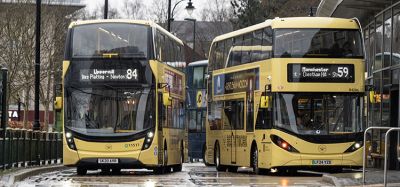Integrated ticketing for Ireland
- Like
- Digg
- Del
- Tumblr
- VKontakte
- Buffer
- Love This
- Odnoklassniki
- Meneame
- Blogger
- Amazon
- Yahoo Mail
- Gmail
- AOL
- Newsvine
- HackerNews
- Evernote
- MySpace
- Mail.ru
- Viadeo
- Line
- Comments
- Yummly
- SMS
- Viber
- Telegram
- Subscribe
- Skype
- Facebook Messenger
- Kakao
- LiveJournal
- Yammer
- Edgar
- Fintel
- Mix
- Instapaper
- Copy Link
Posted: 31 March 2006 | John Churcher, Integrated Ticketing System’s team, Railway Procurement Agency (RPA) | No comments yet
The RPA believes that the Integrated Ticketing System will completely change the way that the general public views public transport across Ireland. It will have such a profound impact that it will be hard to imagine travelling without smart cards.
In 2002, I was invited to review the business case analysis for the surface transport Integrated Ticketing Scheme for Ireland. I did not know then that I was destined to join the Railway Procurement Agency (RPA) in Dublin, and to become the Technical Manager for the design and development of that scheme.
The RPA believes that the Integrated Ticketing System will completely change the way that the general public views public transport across Ireland. It will have such a profound impact that it will be hard to imagine travelling without smart cards. In 2002, I was invited to review the business case analysis for the surface transport Integrated Ticketing Scheme for Ireland. I did not know then that I was destined to join the Railway Procurement Agency (RPA) in Dublin, and to become the Technical Manager for the design and development of that scheme.
The RPA believes that the Integrated Ticketing System will completely change the way that the general public views public transport across Ireland. It will have such a profound impact that it will be hard to imagine travelling without smart cards.
In 2002, I was invited to review the business case analysis for the surface transport Integrated Ticketing Scheme for Ireland. I did not know then that I was destined to join the Railway Procurement Agency (RPA) in Dublin, and to become the Technical Manager for the design and development of that scheme.
RPA has a mandate from the Department of Transport to design an integrated all-mode surface transport ticketing scheme for the island of Ireland, and initially to implement the scheme throughout the Greater Dublin Area using proximity contact-less smart cards.
Proximity contact-less smart cards are credit card shaped plastic cards containing a hidden electronic silicon chip and antenna. They have a long life because they do not require a battery, receiving their power from the card reader/writers by means of radio frequency propagation. Tens of millions of these have been deployed across Europe, Asia and the American continent; they are durable and highly reliable.
The vision
The Republic of Ireland is served by public and private sector licensed scheduled transport service providers. These are: the Córas Iompair Éireann (CIÉ) owned operators Dublin Bus, Bus Éireann and Iarnród Éireann (Irish Rail); Connex – which operates Luas light rail services; and a growing number of privately owned bus operators.
In line with the Government’s vision for a competitive commercial environment, the coordinated services of CIÉ are augmented by Luas and private bus operator services. Some services compete directly for patronage along the same routes as their competitors and external regulation is applied with a light touch.
The vision for the integrated ticketing scheme is to produce a convenient transport passport to allow seamless travel across all modes and service providers while maintaining the autonomy of the publicly and privately owned businesses in relation to their fares and ticket products. Learning from experience in Seoul, Tokyo, Hong Kong and Singapore, the proximity contact-less smart card was selected as the most convenient medium in which passengers would be able to carry and use a range of ticketing offerings and as a means of payment.
The smart card should ease passenger access to transport facilities while improving service provider efficiency through reduced fraud, shorter vehicle dwell times and less cash handling. Transport operators would be expected to pay modest fees to cover the administration of the scheme.
The funding required to develop the infrastructure would have to come from the Government. For the Treasury to approve the budget, the Department of Transport would have to set out a convincing business case which would be revisited at each phase of the project before further funds would be released.
The objective of the project was to achieve a permanent improvement in both the attractiveness of public transport to its efficiency by means of a one-off financial investment to establish a new non-profit making business funded operationally by fees paid by the transit operators. The overall benefits accrued from scheme membership would need to justify the fees charged.
Basic concepts
The smart card itself will provide a secure electronic store where the card holder can put travel tickets and money. Travellers will have the option of buying single operator and multi-operator tickets and storing them on a smart card, or simply storing money in the card’s electronic purse to draw against each time they travel. Passengers will be able to add money and tickets at hundreds of sales agencies and automats.
To use the smart cards passengers simply need to present it to a conveniently placed reader for about a quarter of a second at the start of each journey, and also at the end of a journey if a flat fare does not apply. Other means of ‘topping up’ the smart card, such as internet top-up, will be phased in over time.
The scheme will issue and distribute smart cards, provide an extensive network of sales agencies and check every single smart card transaction at its central clearing house facility. This will provide revenue apportionment and reconciliation services to all transaction acquirers associated with sales agents and transit operators.
Extensive market research and trials have been conducted in Dublin to establish what the public wants from a smart card for travel. We are learning from the experiences of two early adopters which are already using smart card ticketing, Morton’s Circle Line buses and the Luas light rail. These separate schemes have committed to join the integrated scheme when it goes live next year.
Business rules
Operators’ business rules have to be understood and processed by the scheme operator and scheme business rules by all participants in the scheme. Operator business rules refer to things like ticket validity, fares charged, refunds policy, discounting rules and revenue apportionment rules for shared tickets and discounted concessionary travel. Scheme rules are to do with the security and integrity of the scheme like how often financial settlement must occur, how to handle incomplete and missing transactions, date protection and limits to indebtedness.
Many of these rules will be implemented electronically through scheme and operator configuration data distribution. Devices that process smart cards will receive frequently updated manifests of scheme and operator configuration data, application software updates and security key management instructions.
Agreeing business rules with operators invariably is a long and laborious process making it necessary to develop the software for card issuer and back office services using iterative techniques. In other words robust development methods that are resilient to ongoing refinement and change through a planned set of design iterations are required. RPA agreed with its chosen design contractor, Sequoia, to employ the ‘Rational Unified Process’ in four initial design iterations to achieve a business and technical design maturity ready to commence building the system software. This was achieved in June 2004.
After failing to find a suitable partner to build and implement the scheme, RPA and Sequoia have continued to refine the design with the purpose of conducting new and separate procurement exercises of system software build services, scheme operator and sales agency provider.
Regulation and standardisation
Ireland is proudly European. After reviewing national and international standards, we decided to support European developing standards EN1545, IOPTA and IFM. Together these standards provide a framework and basis for interoperable smart card ticketing applications and systems. With the blessing of the National Standards Association of Ireland, RPA has taken a proactive part in developing these standards and our design seeks fully to comply with them.
We believe that these standards will be widely adopted across Europe in the coming years and that they will open up the market place, facilitate inter-operability and help to deliver better value designs. Standardisation leads to open systems development, which levels the procurement playing field while drawing on some of the best expertise in the world to improve the quality of compatibility of related system and device designs.
Because the smart card will have an electronic cash purse to allow you to pay as you go, the scheme will be regulated by the Irish financial regulator, IFSRA, as an ‘Electronic Money Institution’. The regulator will represent the card holders’ interests, ensuring that the liquidity and security of the scheme provides reasonable protection to its users.
Choice of smart card
I wanted to follow best practice by using appropriate technology: cost-justified, secure against ever more sophisticated fraudsters; and flexible, to support a myriad of products and fare rules. Smart card chips have fallen dramatically in price making it ever more important to select the best chip for the job and the right smart card construction processes. ISO standard 7816 describes two families of chip card, type A and type B. Type B cards require more power because they usually employ intelligent microprocessor chips whereas many type A cards are simple memory cards.
After careful consideration, I selected the Philips DESfire chip. It is cheaper than any type B chip I could find, has the processing power and encryption/decryption capabilities I require and has enough memory. In addition it is only a few cents dearer than the equivalent Mifare memory card. I was reluctant to specify the proprietary Mifare security system because I was unable to assess the secret encryption/decryption system.
Cost effective smart card assembly techniques will be evaluated including the use of chips without chip carriers, printed antennas and flexible smart cards that are thinner than the ISO standard dictates but which may be cheaper to buy and are more resilient against bending. Later we will look at alternative ‘smart’ objects like key fobs and watches.
Legacy
Every transit operator has the right to purchase its chosen brand of revenue protection and fare collection equipment. Proprietary systems are deliberately incompatible with each other with regard to how the software works, how the equipment is customised, and how transaction data is configured. We have published a set of generic requirement specifications for devices which can be used within the integrated ticketing scheme.
However, we were concerned that the performance and behaviour of different smart card processing devices might confuse card holders and one proprietary device might corrupt a smart card, making it impossible for another’s equipment to read it.
Further, we reckoned that for each original equipment manufacture to write application software suited to the chosen scheme smart card would be expensive and time-consuming, and would present a burden for testing and maintenance.
We chose to develop a standard card reader for all devices which would fully manage the smart card interface and look after security, presenting simplified, high level messages to the host devices which could be quickly and simply processed. The Smart Card Interface Module (SCIM) was born. This module replaces the card reader circuit in any terminal and in addition to processing scheme smart cards, it can recognise non-scheme smart cards and go ‘transparent’ so that the terminal will still be able to operate other smart cards and their associated applications. SCIMs are fully developed and are presently undergoing rigorous testing in readiness for installation in the field.
Branding, launch, rollout and future
The branding of the scheme is being kept closely under wraps, but not for too much longer. A phased implementation of the scheme is planned for next year. Initially, not all transport operators will be ready to join. RPA will give all necessary support to help every operator to come on board at the earliest possible date.
Existing smart card cards on Luas and Morton’s services will be replaced with scheme compatible smart cards, and any other temporary smart card operations will be withdrawn within a year. We hope that the scheme will expand quickly to cover arterial routes into Dublin and to other Irish cities which, in time, will join together as a national scheme.
The open mode of operation of the SCIM presents an excellent prospect for processing ‘all-Ireland’ smart cards, for example, for use by tourists and concession pass holders. We are precluding nothing in future scheme expansions and we will welcome taxi operators and small value retail outlets to accept the smart card’s electronic purse. Technology advances will always be evaluated and new ideas tested by public consultation. We are presently evaluating mobile phone integration options and ‘Near Field Communications’. The first and main goal however is next year’s exciting launch.
Related topics
Ticketing & Payments
Issue
Issue 1 2006
Related organisations
Railway Procurement Agency (RPA)








